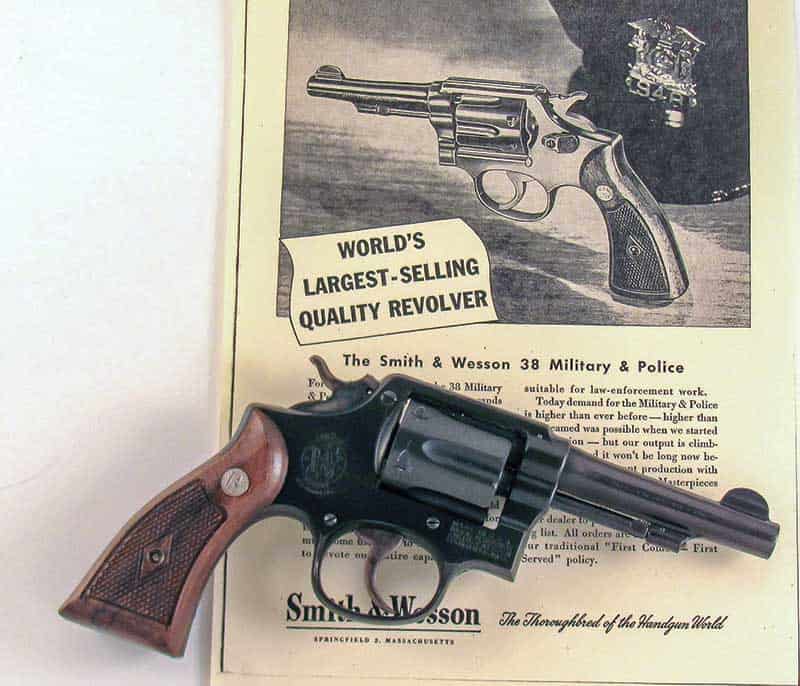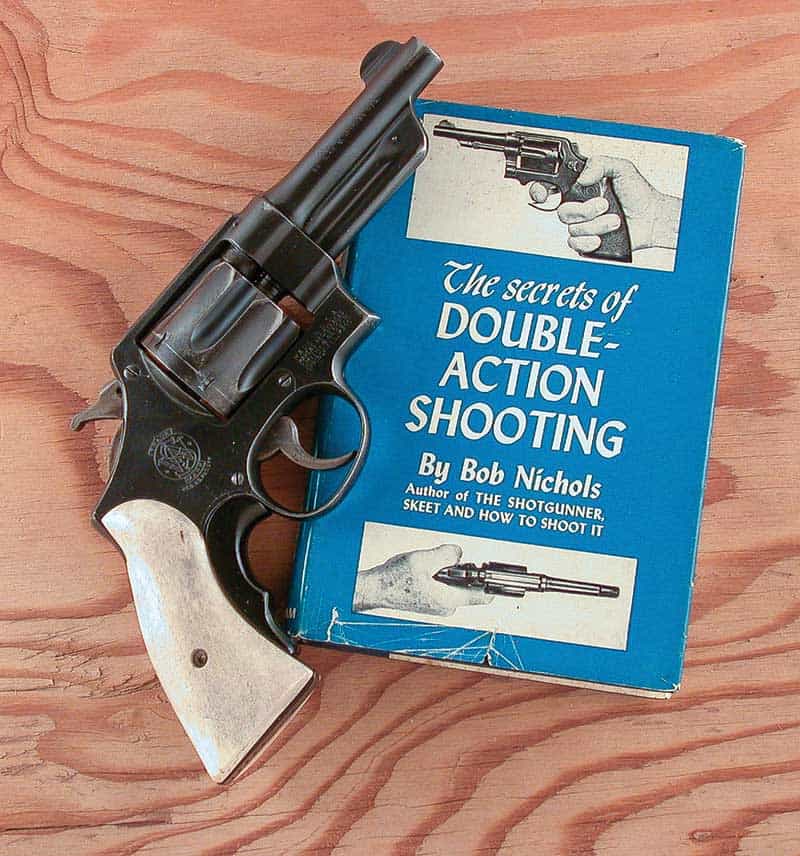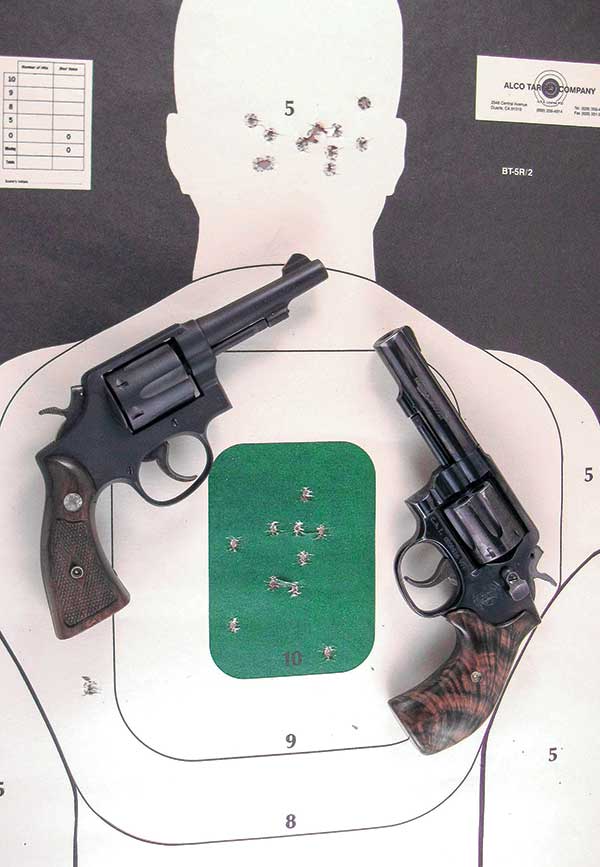From the Taffin Dictionary of Sixgunning — “Perfect Packin’ Pistol is a title given to a sixgun or semi-automatic with a barrel not less than 4″, nor more than 5-1/2″, which can be carried easily all day in a well-designed holster, placed under a bed roll comfortably at night and can be expected to handle any situation which should arise.”
This definition takes in a lot of territory and obviously it depends where the bearer of such a PPP normally finds himself/herself. Whether daily travels take one on concrete, sagebrush, foothills, forests, or mountains, the encounters likely to occur have a great bearing on the caliber chosen have the duty. We will be taking a look at the epitome of Perfect Packin’ Pistols, namely the 4″ Double Action Smith & Wesson.
In The Beginning
To come up with the .38 Special, D.B. Wesson, along with his son, took a good look at the .38 Long Colt, the official U.S. Military Chambering at the time. The brass case was lengthened to accommodate 21-1/2 grains of black powder instead of the standard 18 and the bullet weight was increased from 150 grains to a round-nosed 158-grain bullet.
The new revolver was the first K-Frame and was given the name of Military & Police. For the next half-century plus, it would be found in the holsters of thousands upon thousands of police officers. Over the decades it would be made in the standard barrel configuration as well as a heavy barrel model in both blued and stainless finish. Bill Jordan especially liked the 4″ Heavy Barrel Military & Police in his exhibitions of fast double-action shooting.
With the coming of smokeless powder, the .38 Special was found to be especially accurate and from the very beginning the M&P was offered with target sights. Production of all civilian revolvers was shut down during WWII, however with the end of the war S&W began the development of what would become one of the finest target revolvers ever offered — the K-22.
A Masterpiece
The K-22 was introduced in December 1946 and six months later the first K-38, followed almost immediately by the K-32, arrived. These were all given the title of Masterpiece, which was definitely fitting. I have examples of all three revolvers chambered in .22 Long Rifle, .32 Smith & Wesson Long and .38 Special. They were and are excellent target pistols but too long to be classified as a PPP. This matter was handled in 1950 with the arrival of the 4″ Combat Masterpiece. This magnificent revolver was available in both .22 and .38 with a few examples and .32 Long.
In 1957 the .38 Special Combat Masterpiece became the Model 15 with the .22 Long Rifle version known as the Model 18. For situations where either one of these chamberings will suffice, it would be pretty difficult to find a better choice than the Combat Masterpiece.
The .38 Special, although a great choice for target shooting or plinking, left a lot to be desired in its original round-nosed 158-grain version. After WWI ended, our society was rapidly changing from an agrarian one and many of those who had been content to stay on the farm were now gravitating to the large cities; couple this with Prohibition and the easy money to be made outside the law — as well as the arrival of a new breed of criminal robbing banks escaping in a super-fast V8 powered sedan — and peace officers certainly found themselves behind the times.
The standard .38 Special that had served law officers for nearly 30 years suddenly had to compete with criminals firing .45s and automatic weapons from an automobile. Those little slow moving .38s either bounced off car bodies and windshields or at the very best, offered shallow penetration. Something had to be done to help officers. Smith & Wesson decided a newer and, more powerful, .38 Special was needed and the result was the .38/44 Heavy Duty.
Smith & Wesson, in conjunction with Winchester, in 1930 changed the standard .38 Special using a round-nosed bullet at around 850 fps to a flat-nosed semi-wadcutter design traveling 300 fps faster, and also added a metal-penetrating version. To house this new round, S&W simply used their 1926 Model, or 3rd Model Hand Ejector .44 Special with a .38 Special barrel and cylinder. The result was a much heavier sixgun than the S&W Military & Police and it did an excellent job of dampening recoil even with the new load.
The Military & Police has always been a relatively easy gun to shoot, however this new .38/44 had such a slick action and heavy cylinder it almost seemed to shoot by itself once the trigger action is started. From my perspective it is the finest .38 ever produced; and I am certainly not alone in this assessment. The following came from Elmer Keith.
“About a year ago Smith & Wesson heeded the demand for a heavier .38 with their new .38/44. This weapon was designed primarily as a police weapon and brought out on their .44 Military frame, to my notion the best sized and shaped frame of any double action for my individual hand.”
A New Start
The introduction of the .38/44 sixgun and cartridge did get the .38 Special up off its knees. However, this was only the beginning. The fixed-sighted .38/44 Heavy Duty was offered in barrel lengths of 4″, 5″ and 6-1/2″. In 1931 this latter model was upgraded with the addition of adjustable sights and introduced as the .38/44 Outdoorsman. Just as its name suggests, it became very popular as a field and hunting sixgun. A few were made with the 5″ length and I am certain there were those who shortened the barrel to an easy packing 4″. I had planned to do this someday, however someday has not yet arrived. My itch has been scratched with the use of .38 Special loads in the 4″ S&W Highway Patrolman.
In the early 1930s Col. Doug Wesson and writer/ballistician Phil Sharpe began working together on a new project using the .38/44. Sharpe had the .38 Special lengthened and their work together resulted in one of the finest sixgun/cartridge combinations, the .357 Registered Magnum and the .357 Magnum itself. Smith & Wesson Historian Roy Jinks called it the greatest sixgunning development of the 20th century. I will not argue with the assessment!




4 replies on “PERSONIFICATION OF THE PERFECT PACKIN’ PISTOL THE .38 SPECIAL WRITTEN BY JOHN TAFFIN”
The very first gun I ever fired was a 357 revolver loaded with 38 rounds. That was a great pistol to learn on, i shot for hours that 1st day.
Thanks for thr article, brought back memories.
Your Welcome & thanks for reading my humble Blog! Grumpy
[…] PERSONIFICATION OF THE PERFECT PACKIN’ PISTOL THE .38 SPECIAL WRITTEN BY JOHN TAFFIN […]
Nice article. After packing just about every type of handgun under the sun both professionally and as a non-Leo civilian. I am only concealing one handgun now at 65 years old. A 1980’s S&W 2″ RB model 10 loaded with 158 grain SWCHC +P and carried appendix in a kydex holster. All stock except for a bobbed hammer and some fluorescent orange nail polish on the front sight. I find the original magna grips ideal for concealed carry and ease of drawing under stress. For me its EDC perfection.
It conceals easily without printing under a t shirt. It is easy for me to make accurate shots at 25 yards in DA and most important it is just about the safest gun to administratively handle and holster day in and day out.